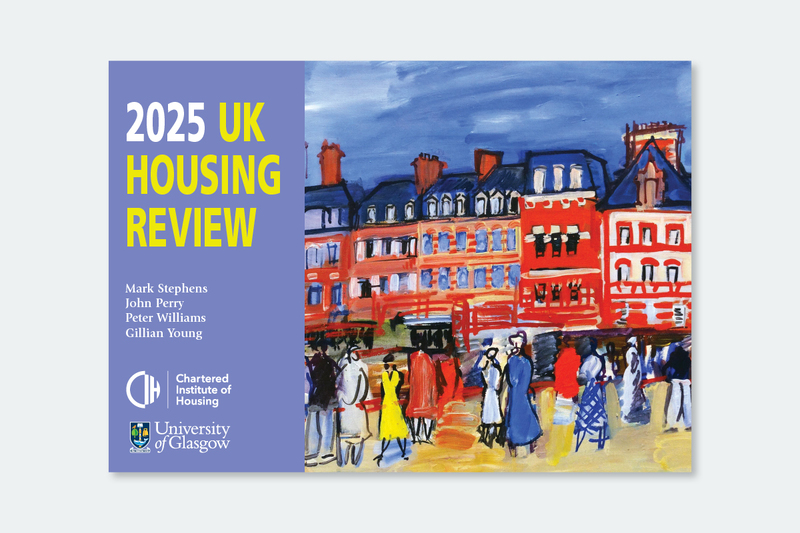UK Housing Review: housing strategy must focus on existing homes
The government must use its housing strategy to give “at least as much weight” to improving existing stock as it has so far given to boosting housebuilding, the UK Housing Review has said.
The Chartered Institute of Housing’s (CIH) report, which is in its 33rd year, brings together the most important housing statistics from across the UK.
It said that as much attention must be given to achieving higher standards in existing stock as is being devoted to delivering new homes. The report said the government’s new housing strategy, which is set to be announced alongside its Spending Review in June, should reflect this.
“The picture that emerges of the existing stock is one where progress is flatlining in improving quality, energy efficiency, safety, and accessibility,” the UK Housing Review said.
“Too many homes still pose a threat of one kind or another to their occupants, and significant investment is required across all tenures and nations to bring all homes up to a standard that provides a healthy foundation for current and future generations…
“The evidence is clear that the new government’s forthcoming long-term housing strategy, announced in July 2024 by the secretary of state, must give at least as much weight to improving the existing stock as it has given, so far, to boosting housebuilding.”
The review said that “policy uncertainties and significant funding gaps have resulted in limited improvements” in recent years across the UK, with private renters suffering the worst conditions.
It showed that the prevalence of disrepair, mould, damp and condensation is unchanged from a year ago in England and Scotland. Meanwhile, the UK Housing Review said that while there is a lack of survey evidence for Wales and Northern Ireland, the same is likely to apply in those cases.
In addition, “incremental progress” has been made in improving the energy efficiency of existing stock, according to the report.
The review said that building and fire safety and accessibility are two additional areas relating to the quality of existing stock that have been prominent in 2024.
Progress is being made on building and fire safety, primarily in England, while the full scale of the problem is still “uncertain”, the report said.
On accessibility, the review said that there is a growing need to adapt the existing UK stock for an older population, which has a greater prevalence of long-term illnesses and disabilities.
“Slow progress in all of these aspects indicates that at least as much attention must be given to achieving higher standards in the existing stock as is being devoted to new housing provision,” the review said.
It added: “The lack of progress is such that calls are growing for what would effectively amount to a new Decent Homes Programme, linked to an updated standard incorporating energy efficiency, climate resilience, and accessibility, and with in-built flexibility for housing providers to use at their discretion.”
The review cited Southwark Council’s call for a new Green and Decent Homes Programme that envisions a new capital programme that would bring all council housing up to a new standard of safety, decency and energy efficiency by 2030.
It also highlighted what it called “the more ambitious” example of Fabian Society’s recent calls for a Social Housing Quality Fund. This would consolidate existing funding streams for energy efficiency and building safety into a single long-term capital programme to bring all social homes up to a new ‘Good Home Standard’.
“Common to these proposals are a desire to move away from what could be termed ‘the fragmentation of quality’ into different domains of energy efficiency, safety, and so forth, and an insistence that a transition to a single, long-term flexible quality funding stream would accelerate delivery by reducing the resources required to make applications to multiple funding sources, and by giving providers certainty to plan and borrow,” the review said.
Energy efficiency
On energy efficiency, the UK Housing Review also said that while decarbonising the housing stock has become a policy priority, “much less attention” is given to the impacts of global warming for homes and residents.
The review said that an adaptation programme is needed that integrates energy efficiency, low-carbon heating and climate resilience measures.
It said this requires investment – speculatively labelled a ‘Futureproofing Homes Fund’ – which could take the form of a capital programme modelled on the “broadly successful” Decent Homes Programme.
The report said that the main difference would be that funding through this programme could be used to upgrade homes to comply with a new ‘Criterion E’. It said this would mean that a home can only be classified as “decent” if “it is sufficiently resilient to risks associated with a hotter climate”.
“Similar changes would be required to standards applying in Scotland, Wales and Northern Ireland,” the review said.
“Doing so would require a transition in the eligibility criteria for government home upgrade programmes, away from EPC ratings and towards a more holistic definition of a safe, decent, futureproofed home. The cost of this programme would be large, but the cost of not developing it is potentially far greater.”
Development
The UK Housing Review said that “intense pressures” on social landlords’ finances across the UK continue and national budgets for affordable housing investment have been constrained. This is despite some easing with the new UK government and its Autumn Budget.
Nevertheless, the report showed that there are shortfalls against the respective targets for affordable housing across the four nations.
The review revealed that England under-invests in affordable housing compared with Scotland, Wales and Northern Ireland. It produces fewer affordable homes per 10,000 population, while housing also has a consistently lower share of government spending.
England also continues to be “out of step” with the rest of the UK in directing a high proportion of government support towards the private market, the report said.
England’s Affordable Homes Programme (AHP) 2021-26 started in April 2021 with a public target to achieve 180,000 starts by 2026. The target has been revised down in stages to 110,000-130,000 affordable homes, of which at least 40,000 are for social rent. However, this reduced target was set before extra funding of £500m was allocated in the Autumn Budget, the report noted.
The next phase of the AHP, to start in 2026, will be determined in the upcoming Spending Review.
“This decision, and other coming policy decisions, will be crucial in determining the success of the government’s overall target of providing 1.5 million homes in England in the current parliament, since affordable housing investment is key to achieving it,” the review said.
It said that Scotland has an “ambitious” commitment to deliver 110,000 affordable homes by 2032, with at least 70 per cent being for social rent.
Despite this, funding dropped in 2024-25, although December’s draft Scottish Budget saw an increase of 26 per cent for 2025-26 compared with the previous year. However, its aim of providing 8,000 affordable homes is “still well short of the numbers needed to meet the target”, the review said.
Wales’ Programme for Government 2021 to 2026 aims to deliver 20,000 new low-carbon homes for rent within the social sector over five years. Total output in the first three years was 8,933. However, the UK Housing Review said that with over 11,000 more homes needed to meet the target by the end of 2025-26, output will have to “increase substantially”.
Following the return of the Northern Ireland Assembly, a new 15-year housing supply strategy published in December 2024 set a goal “to deliver at least 100,000 homes and more, if needed, with one third of these being social homes”.
The UK Housing Review said this strategy implies an annual target of 2,200 additions to the social housing stock.
“However, the budget for 2024-25 was set at a slightly lower level than for the previous year, an amount judged sufficient to build only around 1,400 homes, well below the long-term target,” the review said.
Homelessness
Elsewhere, the review showed that all the UK administrations have adopted measures to tackle homelessness, but during 2024 more households were affected, more were enduring long stays in temporary accommodation (TA) and more people were sleeping rough.
‘Core homelessness’, which includes rough sleeping, use of unconventional accommodation and unsuitable TA, is also increasing across Great Britain, with the rate per 100 households highest in England, the report showed.
However, the report said that statistical modelling on ‘core homelessness’ offers “potential grounds for optimism”. This analysis indicates that several factors altogether can bring about “significant reductions” in even the most acute forms of homelessness.
These are prevention measures, an increased supply of social housing – especially if accompanied by increased allocations to core homeless households – and more effective social security provision.
“The challenge now lies in mobilising the political will, resources, and capacity required to ensure these promising legislative and policy shifts translate into tangible progress, such as that achieved under the previous Labour government’s successful initiatives to drive down numbers who were rough sleeping and in TA,” the UK Housing Review said.
“However, with the UK economy still fragile, local authorities straining under beleaguered homelessness systems, and the Westminster government’s homelessness strategy for England as yet unclear, it remains uncertain whether the levels of intervention needed to reverse current trends can be achieved and sustained.”
Housing in rural areas
The UK Housing Review also found that rural areas experience a shortage of affordable housing, which is a consequence of four inter-related factors.
These are limited land supply, weak planning policy, high costs of developing small schemes in rural locations and limited support for constructive community engagement.
The review said that both England and Scotland offer some support for community engagement in rural housing development but added that “there are no guarantees that it will continue in the longer term”.
The review said: “This appraisal shows that there is a somewhat disjointed approach to rural housing provision in England, with a more strategic response in Scotland. However, the future is still rather bleak.
“There remains a disjuncture between strategic and detailed local policies and between them and implementation. Policies at all levels often pull in different directions and there continues to be limited capacity to develop the small housing schemes needed in rural areas.”
‘Decisive time for government’
Commenting on the launch of the 2025 UK Housing Review, held at the House of Lords on 24 March, Lord Best urged all political parties to engage and utilise the publication.
A former chief executive of the National Housing Federation (NHF) from 1973 to 1988 as well as of the Joseph Rowntree Foundation and the British Churches Housing Trust, Lord Best is currently chair of the All-Party Parliamentary Group (APPG) on Housing and Care for Older People. He is also a co-chair of the APPG on New Towns.
“The review is invaluable at any time but especially now when the government is preparing a new housing strategy and has set a target to deliver 1.5 million new homes,” Lord Best said.
Gavin Smart, chief executive of the CIH, added: “This year’s UK Housing Review is published at a decisive time as the government prepares a new housing strategy to back its target to build 1.5 million homes.”
He added: “Valuable reading for everyone in the sector, I urge all political parties to engage with the wealth of information and analysis available in the UK Housing Review series.”
Sign up for Social Housing’s weekly news bulletin
Social Housing’s weekly news bulletin delivers the latest news and insight across finance and funding, regulation and governance, policy and strategy, straight to your inbox. Meanwhile, news alerts bring you the biggest stories as they land.
Already have an account? Click here to manage your newsletters.
RELATED








